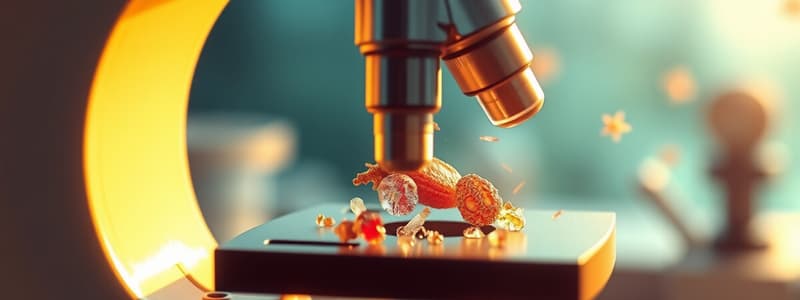Podcast
Questions and Answers
What is the primary function of a microscope?
What is the primary function of a microscope?
- To analyze physical properties of materials
- To examine and analyze biological specimens (correct)
- To study large objects
- To measure the chemical composition of substances
Which of the following best defines magnification in the context of microscopes?
Which of the following best defines magnification in the context of microscopes?
- The ability to enlarge the image (correct)
- The ability to view specimens in color
- The ability to view three-dimensional samples
- The clarity of the image observed
What distinguishes light microscopes from electron microscopes?
What distinguishes light microscopes from electron microscopes?
- Light microscopes use visible light while electron microscopes use beams of electrons (correct)
- Light microscopes can only view biological specimens, while electron microscopes can view any material
- Electron microscopes are portable while light microscopes are not
- Light microscopes achieve higher resolution than electron microscopes
Which type of microscope is specifically mentioned for studying the topography of solid samples?
Which type of microscope is specifically mentioned for studying the topography of solid samples?
What is a common use for compound microscopes in pathology labs?
What is a common use for compound microscopes in pathology labs?
Which of the following is true regarding scanning electron microscopes (SEM)?
Which of the following is true regarding scanning electron microscopes (SEM)?
Which type of microscope is NOT categorized as a light microscope?
Which type of microscope is NOT categorized as a light microscope?
What can be viewed under both simple and compound microscopes?
What can be viewed under both simple and compound microscopes?
What is one primary function of an electron microscope?
What is one primary function of an electron microscope?
Which part of the microscope is used to hold the slide in place?
Which part of the microscope is used to hold the slide in place?
What feature allows the observer to focus more finely on a specimen within a microscope?
What feature allows the observer to focus more finely on a specimen within a microscope?
Which component of a microscope is responsible for controlling the lighting to the specimen?
Which component of a microscope is responsible for controlling the lighting to the specimen?
Which adjustment system do the fine and coarse focus knobs share in a microscope?
Which adjustment system do the fine and coarse focus knobs share in a microscope?
What magnification range do objective lenses in a typical microscope cover?
What magnification range do objective lenses in a typical microscope cover?
In what context are electron microscopes primarily utilized?
In what context are electron microscopes primarily utilized?
What is the purpose of the stage in a compound or simple microscope?
What is the purpose of the stage in a compound or simple microscope?
Flashcards are hidden until you start studying
Study Notes
What is a Microscope
- A microscope produces enlarged images, allowing close examination of minute structures.
- Primarily used for biological examination and analysis.
Functions of a Microscope
- Main functions are magnification (enlarging images) and resolution (analyzing details).
Types of Microscope
Light Microscopes
- Utilize light to magnify objects, refracting light to create a close-up view.
- Types include:
- Compound Microscope: Employs multiple lenses for higher magnification.
- Simple Microscope: Uses a single lens, similar to a magnifying glass.
- Dissection (Stereo) Microscope: Enables three-dimensional viewing of larger specimens.
Electron Microscopes
- Employ beams of electrons instead of light for imaging.
- Two primary types:
- TEM (Transmission Electron Microscope): Electrons pass through thin specimens to create detailed images.
- SEM (Scanning Electron Microscope): Scans the surface of specimens using focused electron beams.
Compound Microscope Functions
- Simplifies the study of microorganisms, viruses, and bacteria.
- Commonly used in pathology labs for disease diagnosis and forensic laboratories for fingerprint analysis.
- Useful for microbiological studies and soil particle investigation.
Dissection Microscope Functions
- Useful for studying the surface details of solid samples, dissections, and microsurgical tasks.
- Applied in forensic engineering for detailed examinations.
Electron Microscope Functions
- Expensive tools primarily used in medical and industrial research.
- Functions include micro characterization, tissue imaging, device testing, and mineral liberation analysis.
Parts of a Compound or Simple Microscope
- Ocular/Eyepiece: Lens through which the observer views the specimen.
- Eyepiece Tube: Supports the eyepiece above the objective lenses.
- Objective Lenses: Main lenses, ranging from 4x to 100x magnification; typically 3 to 5 on a microscope.
- Nosepiece: Holds the objective lenses and allows for rotation among them.
Focusing Mechanisms
- Fine and Coarse Focus Knobs: Coaxial knobs for adjusting focus, crucial for clarity.
- Condenser Focus Knob: Adjusts the condenser height for optimal lighting.
Stage and Slide Mechanics
- Stage: Platform for placing specimens; often equipped with a mechanical stage for precise adjustment.
- Stage Clips: Secure the slide in place for examination.
- Aperture: Small hole in the stage allowing light to pass through the specimen.
Illumination
- Illuminator: Light source located at the microscope's base, essential for proper visibility of specimens.
Studying That Suits You
Use AI to generate personalized quizzes and flashcards to suit your learning preferences.




